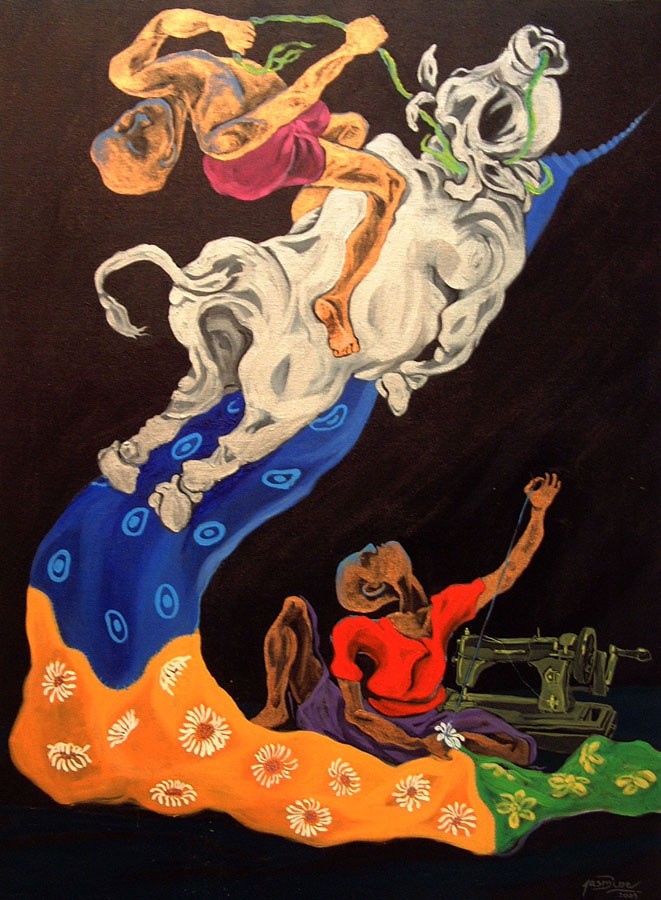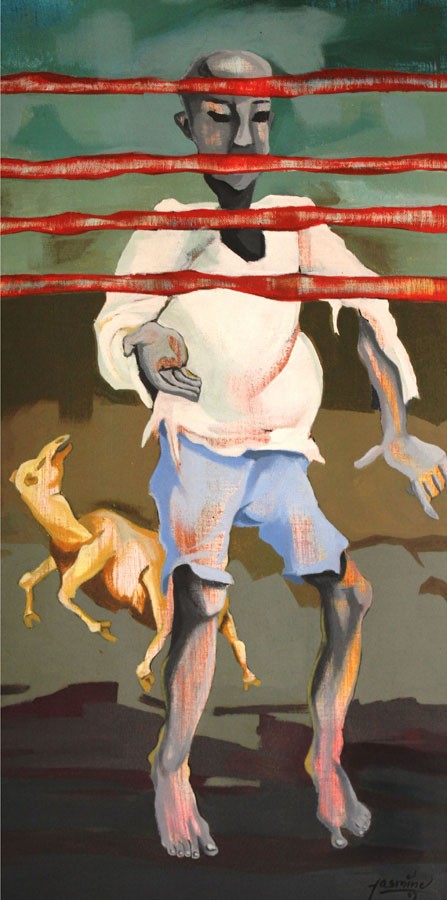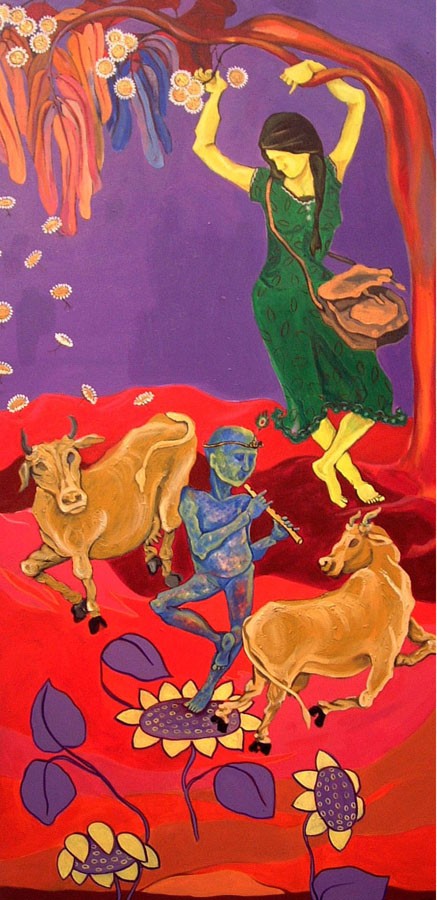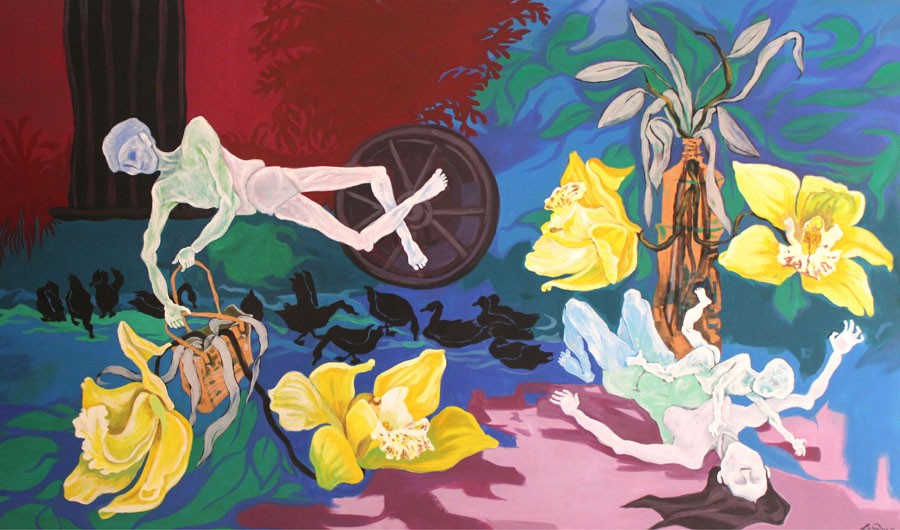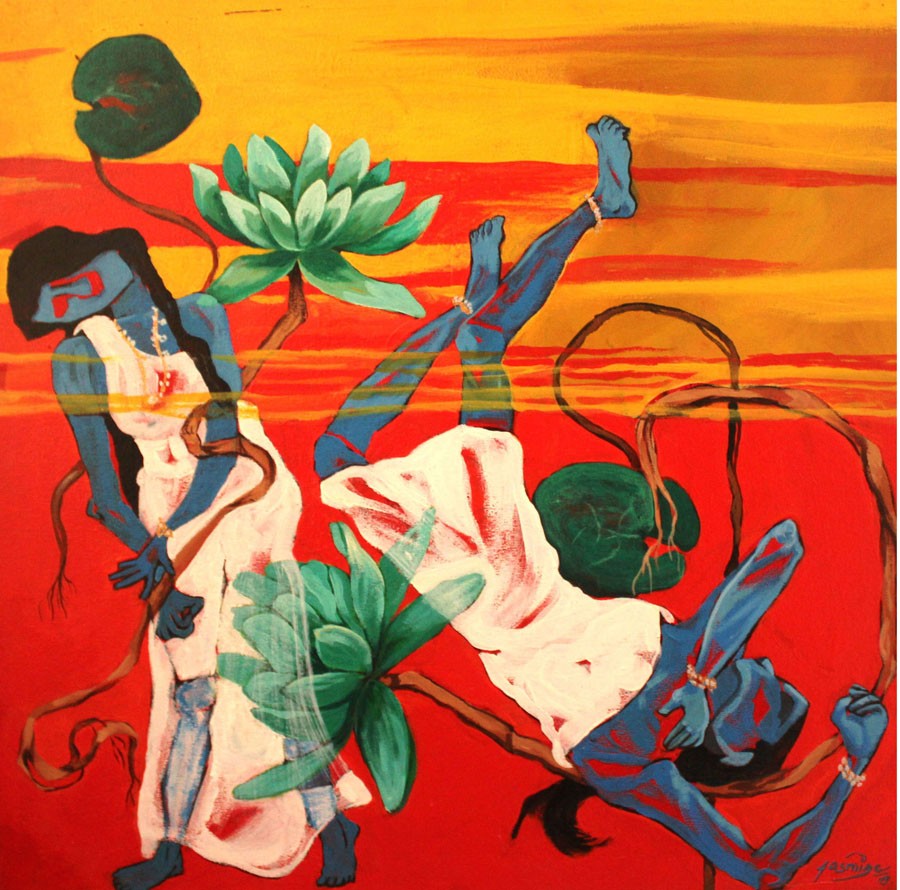Jasmine Rajbhandari Pant
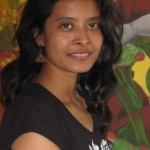
Jasmin Rajbhandari’s paintings strike a balance between the instinct and the reason, tradition and modernity, global and local. Her innate desire to grow, expand and develop is represented by protruding women from the blossomed flower. By taking the image of flower, she connects her artworks with the native tradition of art and the nature at the same time. Flowers like lotus are the recurrent images and symbols in early Nepali paintings.
Jasmin Rajbhandari’s paintings strike a balance between the instinct and the reason, tradition and modernity, global and local. Her innate desire to grow, expand and develop is represented by protruding women from the blossomed flower. By taking the image of flower, she connects her artworks with the native tradition of art and the nature at the same time. Flowers like lotus are the recurrent images and symbols in early Nepali paintings. As her female figures are on the process of growing in a fully fledged form, she faces obstacles and boundary, then, they are forced to use their reason to readjust themselves in the context. However, sooner or later, they are determined and confident to break the boundary and go forward to their goal.
The recurrent images of flowers have further connotation. Flowers present a sense of sensuality, beauty and rhythm. Her female characters assimilate with flowers with intense ecstatic mood and passion. The women are in the quest of something extreme satisfaction. Despite the fact that male characters are also present, the real protagonists are women. The males remain in periphery. She subverts the patriarchal order and norms of the traditional society.
Jasmin also recycles the mythical figures like Shiva and Parvati. However, she subverts them exploiting modern techniques of paintings. The figures do not appear referential and representational as we find them in early forms of art. The figures are distorted, and the colours are altered and unusual. One image melts into another in rhythmic manner as in dream. The local contents come into dialogue with global form. They speak of the cultural self and the cultural other. As the artistic forms are plural and open-ended, their significances are contingent, multiple and provisional. Thus, she maintains balance between tradition and modernity.
Her colours and figures are not overt, aggressive and loud but calm, muted and dim. She attempts to dig out something invisible and intangible substances
Daughter of: Mr. Prem Man Sing Rajbhandari & Anju Maskey
Born in: 1980 A.D. Nepal
Bachelor of fine arts, 2002: Fine Arts College, T.U. (Nepal)
Masters in Fine Arts, 2005: B.H.U. (India)
Asst. Lecturer: Fine Arts College, TU.
Art teacher: Kendriya Vidhyalaya. Embassy of India to Nepal.
Member: Artists’ Society of Nepal.
Senior Guide: Altamira School of Visual Arts.
Religion: Hindu.
Language: Nepali, English, Hindi.
Group Painting Exhibition:
1997: VNY’98, Nepal art council- Kathmandu.
1997: VNY’98, City hall-Pokhara.
1998: Fine arts college-Kathmandu.
1999: Grand art exhibition, Nepal art council-Kathmandu.
1999: Group-painting exhibition, Fukuwoka city-Japan.
1999: Grand creators, great creation’, J art gallery- organized by; Zero century fine arts foundation.
2000: Expo-2000’ Hanover Germany.
2000: Group-painting exhibition, Fukuwoka city-Japan.
2001: Eternal existence’ Nepal art council Kathmandu…organized by, Zero Century fine arts foundation.
2001: Eternal existence-Pokhara…organized by, Zero Century fine arts foundation.
2001: Nepal Tourism Board-Kathmandu.
2001: National Art & Craft Exhibition, NAFA-Kathmandu.
2002: National Art & Craft Exhibition, NAFA-Kathmandu
2002: Lyrical Shades’, Nepal art council-Kathmandu,- by, Zero Century fine arts foundation.
2002: Arrays of echoes’, Hayden Hall-Darjeeling, India,- by, Zero Century fine arts foundation.
2002: Arrays of Echoes, Nepal art council-Kathmandu- by Zero Century fine arts foundation.
2003: National art & craft exhibition, NAFA-Kathmandu.
2003: Joint art exhibition, White Hall-Sikkim, India…organized by Zero Century fine arts foundation.
2003: Group exhibition, NAFA-Kathmandu.
2003: Group exhibition, NAFA Dolakha art camp
2003: Group exhibition, Nepal art council-Kathmandu, by Zero Century fine arts foundation.
2004: Annual Painting Exhibition- B.H.U., India
2004: Group Pianting Exhibition, Jawahar kala Kendra – Jaipur, India
2005: Annual Painting Exhibition- B.H.U., India
2005: 5 men Painting Exhibition-Lene 11 Banaras, India
2005: Group Painting Exhibition, Camlin India ltd. -Kolkata India.
Workshop:
2001: NAFA Gallery-Kathmandu.
2001: Phenomena of creation -organized by, Zero Century Fine arts foundation.
2002: Chaurasta, Darjeeling, India-organized by, Zero Century fine arts foundation.
2003: White Hall, Sikkim, India-organized by, Zero Century fine arts foundation.
2003: NAFA Gallery-Kathmandu.
2003: Art camp, Kathmandu to Dolakha-NAFA.
2004: Mural Painting Camp in Dhulikhel, organize by Zero Century fine arts foundation.
2004: Nathadwara Painting Camp- Gyan Prabha, Banaras, India
2004: Art Fair Workshop in Allahabad University – Allahabad, India
2005: Sanskar Bharati Painting Camp- Banaras India (awarded)
2006: International Art Workshop, Sutra
2008: International residency art workshop, Jyamirkot, Lasana
Award:
1999: Young talented award in water colour, Ranglal Bangdel memorial exhibition.
1999: Later of appreciation, Ministry of Education.
2006: Third Prize, 35th National Art & Craft Exhibition.
Experiences:
– Organizing committee member -Kids’ Guernica-2000, An Intl’ children Mural exhibition-Kath.
– Art teaching in many art camps.
– Co-ordinated many art programmes through Zero Century Fine Arts Foundation.
Collection:
– Japan, Germany, U.K., India, U.S.A., Sri Lanka, Maldives and other personal collections.
